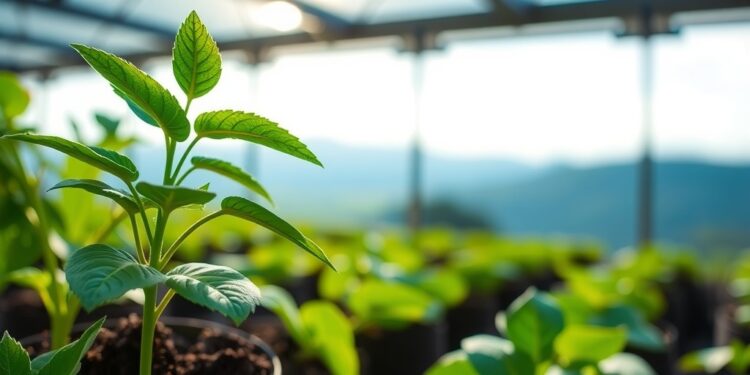A revolutionary study recently published in Science Advances has unveiled groundbreaking strategies aimed at enhancing crop yields by effectively tackling photorespiration, a metabolic process known to diminish productivity by as much as 36% in certain crops. This pivotal research was conducted by a team of scientists from the University of Groningen and Heinrich Heine University Düsseldorf, who are part of the GAIN4CROPS project. Through meticulous evaluations of various alternative pathways, the researchers are working to overcome this significant challenge that continues to hinder agricultural efficiency and sustainability on a global scale.
Photorespiration poses a considerable challenge within the agricultural sector, occurring when the enzyme RuBisCO, which plays a critical role in the photosynthesis process, unwittingly reacts with oxygen instead of the more desirable carbon dioxide. This inefficiency leads to substantial losses in fixed carbon, ultimately costing the agricultural sector billions of dollars each year due to diminished crop productivity. The implications of these findings are profound, as they point toward the potential for engineered pathways to vastly improve the productivity of crops, which is crucial in light of increasing global food demands and the pressing need to adapt to climate change.
The research team utilized advanced mathematical modeling to meticulously analyze twelve alternative metabolic pathways designed to either bypass or optimize the detrimental effects of photorespiration. By classifying these pathways based on their ability to fix carbon, the scientists aimed to identify approaches that promise significant enhancements in crop yields under varying environmental conditions. This analytical framework serves as a roadmap for future research and provides justification for investing further resources into developing genetically engineered crops that can overcome the limitations imposed by traditional photorespiration.
Among the key findings noted in the study, carbon-fixing alternative pathways emerged as the most promising, boasting the capability to facilitate up to 20% more carbon export compared to conventional photorespiration. Notably, the TaCo pathway, a product of a previous EU-funded initiative known as FutureAgriculture, has demonstrated remarkable potential for yield enhancement and is currently being integrated into ongoing projects like GAIN4CROPS and CROP4CLIMA. This multifaceted approach underscores the importance of collaboration across different scientific disciplines and projects in the quest for agricultural innovation.
Virtual simulations conducted throughout the study identified various environmental factors that significantly influence the effectiveness of each alternative pathway. Conditions such as light intensity and the availability of carbon dioxide were found to play integral roles in determining the success of carbon-fixing pathways. Remarkably, these pathways were shown to achieve optimal productivity levels under both high light conditions and situations where carbon dioxide is limited, offering insights into how crops can be engineered to thrive in suboptimal environments.
The research not only lays the groundwork for further study into alternative photorespiratory mechanisms but also provides crucial insights that are anticipated to explain a plethora of existing experimental observations. This foundational knowledge will guide future endeavors aimed at engineering crops characterized by reduced losses from photorespiration. The possibility of reducing these losses brings forth the excitation of not just enhancing yields, but also creating crops that are inherently better suited to cope with the realities of changing climates and resource scarcity.
As the study progresses, the next steps involve optimizing the identified alternative pathways and applying them to crops identified as having the highest yield potential. The implications of these advancements extend beyond mere scientific curiosity; they present a powerful opportunity to address global challenges, including food security and the urgent need for climate change adaptation. By leveraging these insights, researchers can pave the way toward a more sustainable agricultural framework, ultimately contributing to the global effort of ensuring food supply resilience in the face of environmental disruptions.
This elucidating research opens a plethora of doors for future investigations, driving the narrative that achieving high agricultural productivity is no longer an unattainable dream. As scientists refine their methods to engineer crops that circumvent the pitfalls of photorespiration, they contribute to a burgeoning field that could redefine how food is produced. The notion that crops could be tailored through genetic engineering to not only increase yields but also conserve energy represents a seismic shift in agricultural science.
For stakeholders in the agricultural sector, the findings from this study herald a future where crop varieties are specifically designed to meet the demands of a growing population without compromising on environmental integrity. The complexity of photorespiration and the intricacies of plant metabolic pathways speak to a broader understanding of biological systems that could be the key to unlocking sustainably produced food resources. As research communities worldwide begin to embrace these innovations, the collaborative spirit of tackling food security issues will only intensify.
In conclusion, this innovative study elucidates crucial strategies, suggesting a potential pathway to enhance crop yields that could soon become mainstream practice in agricultural methods. By meticulously dissecting the mechanisms underpinning photorespiration, researchers are paving the way for transformative changes that promise to increase food production capabilities when the world needs it most. The integration of advanced genetic engineering techniques into crop development could very well be the solution the agricultural sector has been searching for, a beacon of hope against the backdrop of growing challenges posed by climate change and resource constraints.
Subject of Research: Not applicable
Article Title: Alternatives to photorespiration: A system-level analysis reveals mechanisms of enhanced plant productivity
News Publication Date: 28-Mar-2025
Web References: https://www.science.org/doi/10.1126/sciadv.adt9287
References: 10.1126/sciadv.adt9287
Image Credits: Not applicable
Keywords: Photosynthesis, Plant physiology, Metabolic pathways, Biotechnology, Synthetic biology, Sustainable agriculture




